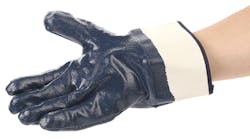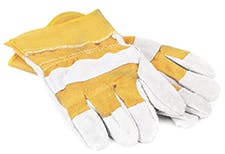When I spoke at an EHS Today/ Dyneema forum during the 2014 ASSE Professional Development Conference and Expo in Orlando, Fla., I conducted an informal hand safety poll. I asked the audience: "How many people have cut their hands?" Everyone in the room raised a hand.
When I asked how many people have had stitches on one of their hands, many people in the room kept their hands raised. Then I asked, "How many people have had stitches more than once?" In a room full of safety professionals, I learned that most people have scratched their hands, and many have had stitches multiple times.
Every scar on your hand has a story to tell and a lesson that you learned the hard way. The key to improving workplace hand safety is helping others see and feel the same lesson that you learned from your hand injury – without the pain.
For example, several years ago, I used a utility knife to cut plastic. The plastic was harder than I expected, and I had to apply pressure to make the cut. When I applied the pressure, the blade broke and my hand slammed into the broken blade stuck in the plastic. I didn't want to look at the damage because I knew that I'd made a mistake. The incident cost me six stitches and a good dose of humility.
As a result of the incident, I cringe every time I see a utility knife. I have a personal, hands-on connection with the risk. A productive hand safety initiative helps others see the reality of the risk without the painful experience.
The Hands-On Safety Champion Program is a process that reduces hand injuries with employee involvement and a hands-on reality check. I cringe when I see a utility knife, and my instinct is to pull back when I have to use one because I remember my lesson. The goal of the program is to instill the same instinctive reaction in others without the pain.
Here's how the Hands-On Safety Champion Program works.
You choose natural leaders (champions) in your workforce and give them the responsibility to focus on hand safety. The program is a 360-degree process that promotes identification, coaching and mentoring through positive peer-to-peer influence.
Champions conduct focused hand-safety surveys with survey cards. The cards have 10 specific bullets that help champions evaluate common risks that cause hand injuries. Champions also use the platform to coach and mentor co-workers. The focused surveys are an opportunity to share their stories to make a hands-on connection.
Step 1: Select your Safety Champions
You need good people to lead the charge. Each supervisor should appoint a safety champion for his or her team. The champions lead the initiative to coach, mentor and observe safe hand behavior in their areas.
Safety champions should possess the following qualities:
- Positive attitude.
- Strong leadership skills.
- Interest in safety.
- Conscientious.
- A desire to achieve safety goals.
Step 2: Clarify Responsibility
Once you have selected your hands-on safety champions, communicate their responsibilities. For example, champions are responsible for:
- Performing weekly hands-on surveys.
- Coaching and mentoring other employees.
- Approaching and coaching others who engage in unsafe behavior.
Supervisors are responsible for:
- Making sure safety champions are able to perform hands-on surveys.
- Supporting the safety champions.
- Meeting with the safety champions weekly.
Program administrators are responsible for:
- Leading the Hands-On Safety Champion Program.
- Coaching and mentoring the safety champions.
- Meeting with the safety champions frequently.
Step 3: Deploy the Process
Champions conduct surveys focused on specific areas of hand safety. They also help coach and mentor employees, and they use these opportunities to share their stories.
The safety champions choose one or more people to accompany them on observation walks, during which they use a survey card with hand-safety audit items. These walks are a perfect opportunity to make a hands-on connection with co-workers by sharing personal examples of the consequences of poor hand safety. Telling your story makes it real.
The champion and the person he or she mentors ask people about hand safety and initiate conversations about hand protection. For example, compare scars! That might sound strange, but I guarantee if you tell a story behind one of your scars, co-workers will follow up with their own version. That is a hands-on connection, and the common ground makes it easier to discuss how to protect your hands. The goal is to help people think about safety-related questions. Each person with whom you talk is a coaching contact.
After the champion completes the survey, he or she should show it to a supervisor and forward it to the program administrator.
At a minimum of once a month, champions should review the findings as a group and discuss how to improve negative trends. The group should include the supervisors and the program administrator.
Conclusion
The Hands-On Safety Champion Program facilitates a discussion about common ground – hand safety. The platform enables you to share the stories behind your scars and instill caution in co-workers. I know what it's like to cut my hand using a utility knife. If I conduct a focused hand safety survey, do you think I can provide insight to someone using a similar tool? Empower your hands-on safety champions to share the same message.
The Hands-On Safety Champion Program works. The key is to select the right people and give them specific tasks that they control, and to provide consistent communication and support. Make it a privilege to serve on the Hands-On Safety Champion Team, and emphasize the importance of each team member's role to encourage others in the workforce.
The scars on our hands are common ground for us, and each scar has a story. When you tell that story, you make a hands-on connection that can inspire your team members to work safer and go the extra mile to protect their hands.
David G. Lynn, CSP, is a vice president of signature services for Greenville, S.C.-based Life & Safety Consultants Inc. A professional speaker and improvement strategist with 20 years of experience in the safety field, Lynn is the author of "Principle to Practice" and "Strategic Safety Plan." Contact him at [email protected].

